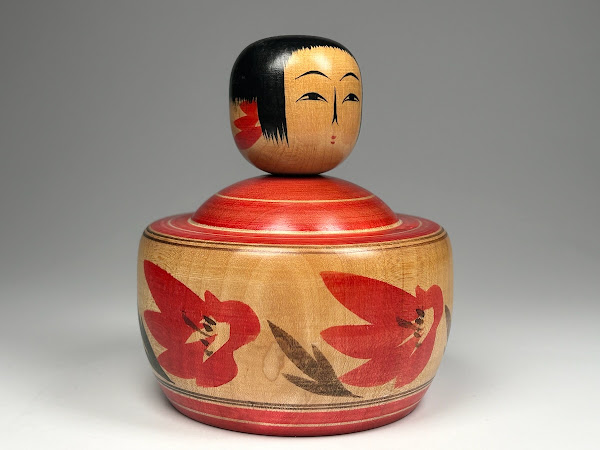えじこの郷土人形 Ejiko Dolls
どちらも「えじこ」に収まった赤子をかたどった東北地方の郷土人形。左は秋田市の八橋(やばせ)地区でつくられた土人形で、おそらく明治中頃のもの。黄、赤、緑、水色などの顔料はいい具合に古色を帯びて、古人形の味わいがよくでている。よくみると水色の布には水玉文様が描かれていて、当時の服飾事情が垣間見える。
右は山形県蔵王温泉在住の岡崎幾雄の作品。基本的には「こけし」の作家さんだが、たまにこういった「えじこ」の作品をつくっているようだ。わたしは特段こけし愛好家というわけではないが、10年くらい前に蔵王の温泉街をぶらぶら歩いて、単にかわいいなとおもって買い求めた。
Both dolls were made in the Tohoku Region, Japan, depicting a baby embedded in an ejiko. The left one is a clay doll made in the Yabase district, Akita, probably in the late 19th century. The traditional yellow, red, green, and light-blue pigments make it attractive. The dot pattern on the light-blue cloth around the neck may indicate the fashion at that time. The right one is a wooden doll made by Okazaki Ikuo, Zao Onsen, Yamagata. He is basically a kokeshi artist, but sometimes made this kind of ejiko dolls. I purchased this doll about ten years ago when walking around the town of Zao Onsen.
「えじこ」とはかつて日本の農村・漁村でつかわれた民具で、親がしごとをしているあいだに赤ちゃんを安全に「閉じ込めておく」ための容れ物である。多くはわら製で、お椀のような半球状に編み込まれている。この中に歩き始める前の乳児を据え置いて周りをふとんでくるみ、さらにひもで縛るなどして身動きがとれないようにする(下の写真を参照)。そして赤ちゃんは基本的にここに放置された状態で日中をすごす。おしっこなどは垂れ流しなので、底の部分にわらや灰などを置いて吸収させ、定期的に取り替えた。「えじこ」は昭和初期頃までは東日本一帯で広くつかわれたというが、衛生面のみならず幼児を身動きのとれない状態で長時間放置するのは発育上のぞましくないといったことが問題視され、急速に廃れた。しかし東北地方の一部では昭和30年代でもまだ使用する家があった。現代では完全に姿を消してしまったが、郷土人形(土人形・木地人形)としての「えじこ」は東北を中心としていまなお親しまれている。
Ejiko was a basket-like apparatus for swaddling a baby, usually made of straw and once used in Japanese farm and fishing villages. A baby was placed inside and covered by cloths, and was often secured with a string (see the photo below). The baby spent a daytime inside the ejiko by itself without receiving any cares. In case of wee-wee, straw and ash are placed at the bottom of ejiko and are thrown away later. Ejiko was used mainly in Eastern Japan before the Pacific War but soon became old-fashioned, because it was not only insanitary but also limiting baby's movement for a long time was considered to be bad from a health standpoint. However, ejiko was still utilized even in 1950s in a part of the Tohoku Region including Akita and Yamagata. Ejiko dolls are widely seen and loved in the Tohoku Region.
補足
参考文献:
- 祖父江孝男・須江ひろ子・村上泰治「エジコに関する文化人類学的研究」(人類学雑誌、66巻 2号、1957年)
- 鈴木常雄「えじこ」(「郷土玩具図説 第4巻」279〜303ページ、村田書店、1984年;原著は1961年)
「えじこ」はふつう漢字で「嬰児籠」と書くが、これは当て字だろう。地方によっては「いづみ・えづめ」「つぐら・ちぐら」などとも呼んだ。ごはんなどの保温容器である「飯詰」を赤ちゃんの保育に転用したのではないかとおもわれるが、実際の語源は不明である。基本的に東日本方言では「い・う・え」の発音は似ていて区別しがたい。また名詞の末尾に「っこ」をつけるのもよくおこなわれる。「いづめっこ」が省略されれば容易に「えづっこ・えじこ」に変化するだろう。転載した塚本の本でも「いつこ」であり、表記のゆれがはなはだしい。



